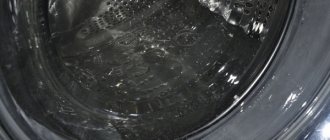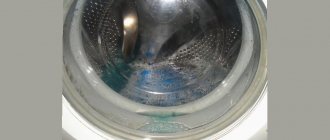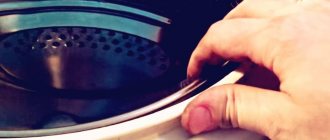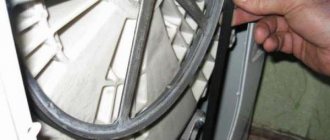During 1 operating cycle, the washing machine draws water at least 2-3 times. A malfunctioning drain can delay the rinse cycle or leave laundry wet despite the spin cycle.
If there is water left in the drum after washing in the washing machine, then you need to check the function of the pump, the settings of the electronic unit, the condition of the valves, filter and pump.
Why does water remain in the washing machine drum?
The reasons for interruptions in drainage may be:
- broken or kinked hose;
- contamination of the filter or pump pipe;
- malfunction of the level sensor (pressure switch);
- drain pump failure;
- failure of the electronic control unit (ECU).
Characteristic symptoms of malfunctions
| Type of failure | Symptoms |
| Pump failure, contamination or pump malfunction | All the collected water remains in the drum, the machine hums loudly when operating. If the liquid drains with difficulty, this indicates a load on the pump due to the extended hose |
| Valve failure | The liquid continues to flow even after the program ends. The unpleasant odor inside the tank increases due to rotting blockage or filling with drains |
| Incorrect operation of the electronic module, clogged filters | Accumulation of water without accompanying symptoms. ECU failure is most often observed on Samsung and Indesit machines |
| Sensor malfunction | A small amount of liquid remains in the tank, the program change is carried out normally, some of the water is drained without signs of pump malfunction |
| Kinked or clogged hose | It is determined visually when there is a blockage, the water does not leave even when manually draining separately from the siphon. If the pipe is in order, then you need to look for a blockage in the sewer |
In working devices, the problem may arise due to incorrect choice of mode. With standard settings, the water is drained during operation, but some units have a “No Drain” function, which is designed for washing delicate fabrics.
Most owners use this mode if they need to leave for a long time before the end of the cycle and leave the car turned off. After a few hours in water, the laundry will not acquire an unpleasant odor or become wrinkled, and after a forced start, the wash can be completed in a few minutes.
Reasons for poor drainage: checking the sewer connection
Sometimes during operation of the washing machine, water appears in the drum.
Modern washing equipment is equipped with an aquastop or check valve that does not allow liquid to flow out. But sometimes the centrifuge fills with liquid, even if all preventive measures are taken.
To determine the cause of the breakdown, it is necessary to analyze the water:
- If it is light and odorless, the machine may have broken down or there is a problem with the plumbing.
- Cloudy and dirty liquid with an unpleasant odor indicates that the machine is not properly connected to the sewer system.
The drain stops working and liquid flows into the tank when the hose is poorly positioned in relation to the water level in the drum.
Therefore, connecting the washing machine is done strictly according to the instructions or a specialist is called. Draining does not work well if the hose is kinked or pinched by something. This can be easily detected and corrected by visual inspection.
How to drain the water
The remaining water is drained through the door, drain pipe, emergency or standard hose. Before starting the task, you need to disconnect the machine from the power supply, study the instructions for the device, prepare a bucket and dry floor rags.
Direct drainage through a door or hatch for storing laundry is only suitable for some models of equipment. Most horizontal machines block the opening of the hatch if there is water in the tank.
How to drain the water from the drum:
- Check the set mode. When the “No drain” function is active, start a forced spin and turn on the machine.
- If the standard settings are in effect, you need to remove the gray corrugated drain hose from the sewer and lower it into a bucket. If the water does not drain or flows slowly, try to clean the opening from the side where it meets the riser. It is not recommended to disconnect the pipe until the tank is completely empty.
- Check for a drain filter or emergency tube at the bottom of the machine. These devices are hidden under the decorative panel. To remove water, you need to carefully turn the handle of the round filter counterclockwise without unscrewing it completely. Place a low, wide container under the filter and place rags. If you have an emergency hose, lower its end into the bucket and open the cap.
Draining through a pipe is resorted to when other options are ineffective. This method is the most complex and time-consuming, so it is used mainly by technicians who repair equipment.
To empty the tank you must:
- move the machine away from the walls and detach the back panel using a screwdriver;
- find a drain pipe under the drum that connects to the pump inlet;
- place a wide bowl or bucket under the hole;
- Carefully remove the clamp holding the pipe together and disconnect it from the pump.
In this case, the water will flow in a stream, so you need to be prepared to frequently change containers and wipe up puddles. If the fluid leaks slowly or does not flow at all, then the pipe itself is clogged.
Level sensor faulty
If liquid remains after washing or the laundry is too wet, the water control sensor may not be working. When water is supplied, the pressure closes the relay, thereby indicating the liquid level. Without a pressure switch, the control unit does not receive data, which means it does not drain. When a machine breaks down, it leaks water because it fills it without stopping. In this case, the device must be replaced with a new one suitable for this model.
The pressure switch is located directly under the cover, so you need to remove it, photograph the position of all the wires, disconnect and attach them to the new sensor in the right order.
There is a simple way to check the health of the sensor. Connect a pipe identical to the one in the car to the disconnected pressure switch and blow into it. A working device makes clicking sounds after blowing. You can also test the conductivity with a multimeter.
Troubleshooting Methods
The cause of the problem is determined by brute force.
First of all, the selected mode is checked.
If the mode for delicate fabrics or “No drain” is active on the display, then you need to start the spin cycle at standard settings.
Cleaning the filter
To clean the pump filter, take the following steps:
- disconnect the machine from the power supply;
- drain the water through a hose or pipe;
- open the decorative cover at the bottom of the front part of the case, unscrew the drain filter;
- if the water flows slowly, remove and clean the filter from debris;
- use a flashlight to illuminate the space behind the filter, check the condition of the pump impeller, and if necessary, free it of hair and debris.
It is also recommended to periodically clean the siphon pipe that connects to the machine. Its lumen can become clogged with debris, detergent residues, wool, etc.
Removing blockages from the drain pump and pipe
To get to the internal parts, you will need to remove the body or bottom of the car. Before repairs, you need to check whether there is water in the powder compartment. Otherwise, when tilting the unit, there is a risk of flooding the electronic control module.
Disassembling the unit will provide access to the pump. It is inspected for blockages and obvious breakdowns. If no contamination is found, you can turn on the device and check the function of the pump. Lack of movement of the impeller on the drain often indicates a winding malfunction. To check it you need to use a multimeter. The burnt winding is replaced separately or together with the entire spare part.
If the impeller is working, then you should release the clamp near the nozzle and check it for blockages. The clogged hole is cleaned with strong water pressure.
Replacing the supply valve
Damage to the valves is identified by the intake of water when the washing mode is not turned on. To check, you can turn off the common water supply tap in the apartment.
Supply and drain valves are repaired by replacing the gasket or the entire part.
Checking and replacing the level sensor
The most common cause of incomplete drainage is a broken level sensor. To check and repair it, remove the top cover of the housing (for horizontal models). The pressure switch (a round part with several wires) is located near the wall of the unit.
Before repairing, you need to photograph the location of the wires, then disconnect them from the contacts and unscrew the mounting bolts. The sensor tube is purged and inspected for damage, and the pressure switch itself is checked using a multimeter.
If the resistance differs from the standard one and indicated on the part, then the sensor should be replaced.
Inspection of the electronic unit
It is not advisable to repair the ECU yourself. Exceptions are cases of severe oxidation of contacts or visible breaks in the tracks on the board, which can be eliminated by soldering.
The control system has failed
Everyone is accustomed to the fact that in modern automatic machines, water is drawn and drained automatically; control module programs are responsible for everything. It controls the temperature of the heating element, turns on the drain pump, regulates the power of the electric motor, and controls the water pressure during supply.
A common cause of breakdown is a manufacturing defect, failure of auxiliary sensors, or a simple flood of water. Therefore, if the inlet valve has already been replaced and the machine is still not working properly, then the board has failed.
Indesit, Samsung and BEKO cover their boards with sealant in some models. If, when opening the front panel, changes in color, swelling, or burnout are found on the microcircuit, then it is better to call a technician who knows how to handle a blowtorch. If you do not have sufficient knowledge, you should not repair the circuit yourself.
If drops are visible on the board, but there is no noticeable damage, you can dry the chip, in most cases this gives a positive result.
What to do if water is constantly pouring into the drum of the machine
A continuous supply of water may mean that the pressure switch, ECU, tank or inlet valve has failed. If the tank breaks down, the unit is able to maintain the required level only through continuous operation of the pump.
Troubleshooting depending on the nature of the problem
| Character | Possible reasons | Repair |
| The problem appears in the new device | Manufacturing defect or incorrect connection | Raising the drain point above the tank level. Diagnostics of the main systems of the device, replacement under warranty |
| Uncontrolled water intake after long-term proper operation | Level sensor failure | Removing blockages in the supply tube of the pressure switch, cleaning oxidized contacts, replacing the membrane. Replacing the sensor |
| Pump operation when the wash is turned off | Intake valve malfunction | Replacing the membrane or the entire part |
| Leakage on the floor during continuous typing | Tank breakdown or crack. Supply hose leaking | Replacement of damaged spare parts. In some cases it is possible to solder the tank |
| Other faults | Incorrect operation of the electronic unit | Diagnostics of functions under service conditions, checking the condition of the board. Replacing or flashing the control system |
If the washing machine is working properly, then the problem may lie in the design of the siphon to which the drain hose is connected. When there is a vacuum in the sewer system, a pressure difference is created at the outlet of the unit, which draws out water and forces the pump to restore the required volume to complete the cycle.
The design flaws of the sewer siphon affect not only the operation of the machine, but also the function of the water seals in the toilet, bathtub and sink. If there is periodically no water in the toilet, then the issue with the operation of the washing pump can be solved by installing an anti-siphon valve on the drain hose.
Prevention measures
How to avoid such an unpleasant situation as water in the drum of a washing machine? Here are simple but effective tips:
- Be sure to follow the manufacturer's instructions.
- Wash items according to the instructions on the labels.
- When loading things into the car, be sure to check the pockets: they may contain extra parts that could remain inside the device and cause damage.
- Make it a rule to organize cleaning of your car using special products. For example, regular citric acid will do.
- Periodically check your equipment for the possible presence of failures and malfunctions: timely identification of the problem will make it possible to more effectively eliminate possible failures.
If you are not entirely sure that you can handle the breakdown yourself, there are specialists who will repair the damage. However, take your time and try to inspect the condition of the equipment yourself: you will save time and money.
Preventive measures for equipment breakdowns
To prevent malfunctions you need:
- check things before washing, remove small items and garbage from pockets;
- clothes decorated with sequins and rhinestones should be washed only at low speeds and on the wrong side;
- periodically run a wash cycle with warm water without clothes and add a descaling agent to the drum;
- after the end of the cycle, close the outlet valve to prevent wear of the membrane;
- regularly inspect and diagnose the ECU according to the manufacturer's recommendations.
To prevent the collection of waste from the sewer, it is recommended to install a check valve at the junction of the siphon and the drain hose.
Clogged filter, drain hose, sewer
Pieces of paper from pockets, crumbs, sand get stuck in the filter, blocking it. The manufacturer has provided for this possibility and installed a filter in the lower corner of the machine under the loading hatch. Just unscrew the filter, look inside, and clean out any accumulated debris. If debris is not found on the impeller itself, then you need to illuminate the inside of the housing to look for blockages.
Pieces of fur or sand may have passed further into the drain hose, which should also be removed and checked. It may have been connected incorrectly, connected too high to the siphon.
The problem may be in the siphon or sewer pipe itself; food debris also accumulates there, hair and grease collect. Phosphate-free powders heavily clog pipes, so you will need a metal pipe cleaning hose 3–5 meters long. At the same time, the siphon is removed and washed. If all of the above actions do not bear fruit, then it is worth checking the pump.
How to prevent this error from appearing
To prevent water from remaining in the washing machine after washing, it is important to follow the installation and operation rules specified in the instructions.
- It is not recommended to increase the length of the drain hose, as this significantly increases the load on the pump and it quickly breaks down.
- Before washing, you should carefully check your pockets for foreign objects. Items decorated with rhinestones, sequins and the like are recommended to be washed in special bags.
Call the workshop "RemBytTech"
If you are not sure that you can cope with the problem yourself when a switched-off washing machine fills with water, call the RemBytTech workshop
7 (495) 215 – 14 – 41
7 (903) 722 – 17 – 03
and entrust the repair to professional craftsmen.
- telephone consultation;
- qualified craftsmen;
- repairs at your home within 24 hours after your request;
- free diagnostics (if the repair is carried out by our technician);
- Warranty up to 2 years on all spare parts and work performed.
or via online application.
Within 24 hours after receiving your application, a qualified technician will come to your home and return your washing machine to its former performance.











